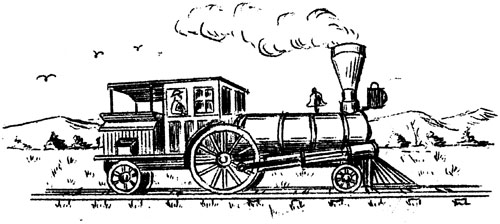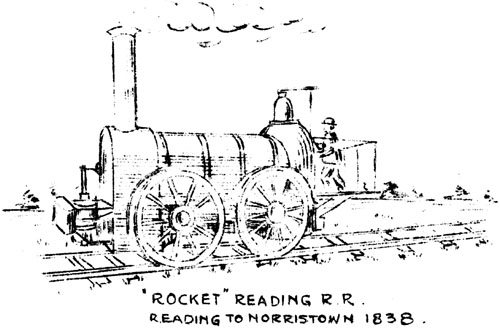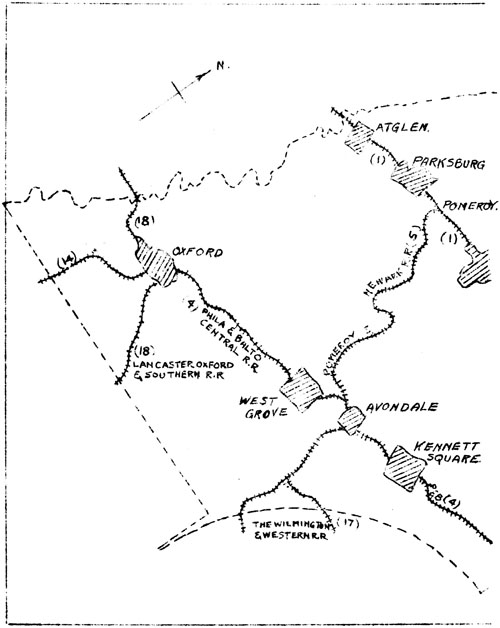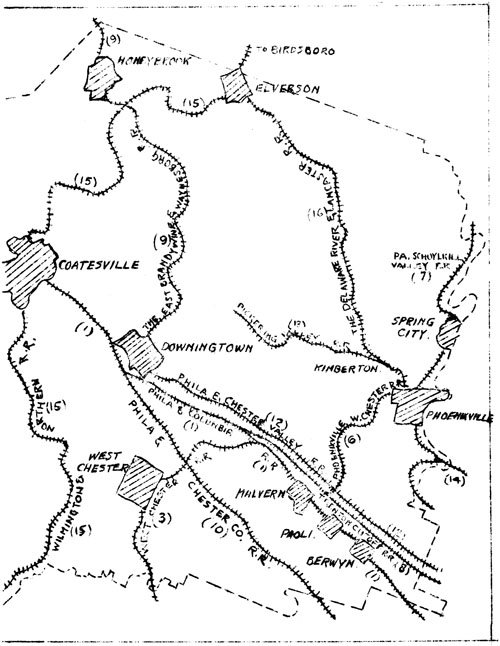|
Home : Quarterly Archives : Volume 7 |
Tredyffrin Easttown Historical Society |
|
Source: February, 1953 Volume 7 Number 4, Pages 86–94 The railroads of Chester County
The people of every section of the United States became very speedily convinced, when railroads were first projected, that this new means of travel was the complete answer to all their transportation problems. These problems arose from the generally bad condition of the highways everywhere, which prevented free communication for passengers and freight, limited the settlement and growth of the country in general, and made the delivery of mail a very slow and tedious process, especially in the winter months. The railroad, even in its first undeveloped condition, was instantly seen to be of immense value not only as a convenience in travel but as a market outlet for crops and manufactured goods and mines, and as a peaceful means for strengthening the ties of friendship and commerce among our states and cities. The railroad did more to make the states truly "united" than any other factor in our history except the Constitution as adopted. As the railroads became perfected and their advantages more apparent, Americans everywhere, with their keen judgment and will to take advantage of opportunities to better their lives in general, were eager to enjoy the pleasures and profits of easy communication, and, during the years from 1835 to 1875, the people of our County were as interested as any others in promoting the extension of railroads. As time went on, the small railroads of the County became absorbed completely into the two great systems of the State - the Pennsylvania Railroad and the Reading Company. No independent roads now exist, all from time to time having been absorbed by the two giants mentioned and operated as their controllers' best interest indicated. This absorption was a comparatively easy process, as the influence of the small roads was very weak, the County having so few towns of any size located away from the main lines and thus not commanding the big business required to support railroads. Eighteen separate railroads originally operated through our County, they were: (1) THE PHILADELPHIA & COLOMBIA RAILROAD, The honor of being the first railroad to be built through Chester County seems to belong to the State-owned and operated Philadelphia and Columbia Railroad, extending from Broad and Vine Streets, Philadelphia to Columbia, on the Susquehanna River, a distance of about 82 miles, of which about 32 miles was in Chester County. This line was chartered under the Act of March 24, 1823 and was opened for operation April 16, 1834. This railroad was purchased in 1857 by the Pennsylvania Railroad from the State of Pennsylvania, together with a large system of canals, the two together being termed the "Main Line of Public Works," from which we get our popular name of "Main Line" for this section of our County. From this modest beginning has risen "The Standard Railroad of America"--the great Pennsylvania Railroad. Since 1857 the following local railroads have been incorporated into its system: (2) THE WEST CHESTER RAILROAD was chartered February 13, 1851, to be constructed to a point on the Columbia called "Intersection", now Malvern. Malvern was the junction until 1878, when the railroad was diverted at Zermatt Station (now Morstein) to run down into the Chester Valley to Frazer, where it made connection for Phoenixville. This railroad was acquired by the Pennsylvania, together with the other West Chester & Philadelphia Railroad running via Media, in 1879. (3) THE WEST CHESTER & PHILADELPHIA RAILROAD about 30 miles in length, was opened for traffic November 11, 1858. This line was known as the "Direct" routes to Philadelphia, running to West Chester Junction (now Wawa) where it was joined by the Philadelphia & Baltimore Central Railroad. It passed into control of the Philadelphia, Wilmington & Baltimore Railroad and was included in the transfer of that line to the Pennsylvania Railroad, March 8, 1381. (4) THE PHILADELPHIA & BALTIMORE CENTRAL RAILROAD was incorporated March 17, 1853. It was built to Oxford in 1859 and finally completed to Perryville, Maryland, in 1869. It had many financial troubles and was finally acquired by the Pennsylvania in July, 1881. Its length in Chester County is about 36 miles. (5) THE POMEROY. & NEWARK RAILROAD. Chartered originally in 1833 as the Doc Run & White Clay Creek Railroad, its name was later changed to the Pennsylvania & Delaware Railroad. It was leased to the Pennsylvania Railroad and in 1879 the lease was cancelled and the road foreclosed, in 1881 the Pomeroy a Newark Railroad was formed and since operated by the Pennsylvania Railroad. (6) THE PHOENIXVILLE & WEST CHESTER RAILROAD was begun in 1882, extending 11 miles from Frazer to Phoenixville, where it was planned to join the Schuylkill Valley Branch of the Pennsylvania Railroad. On August 1, 1883 this road was opened for operation. During the year 1834 the entire Schuylkill Valley Branch, extending from 52nd Street to Reading, was opened to travel. It is noteworthy that the Phoenixville & West Chester Railroad was opened first, although it was merely a branch of the Schuylkill Valley line. (7) THE PENNSYLVANIA & SCHUYLKILL VALLEY RAILROAD, the parent line of the above-mentioned Phoenixville & West Chester Railroad, was opened for use in 1884. It traversed the northern edge of the county, passing through Phoenixville and Spring City, and finally reached Pottsville and tapped the great anthracite coal regions of Pennsylvania. (8) THE TRENTON CUT-OFF RAILROAD and THE LOWGRADE FREIGHT LINE. The Trenton Cut-off Railroad (for freight service), owned and operated by the Pennsylvania Railroad, extending from Glen Loch across the County through the Chester Valley to a point east of New Centerville, and thence to Morrisville, N.J. Its construction began in 1889, and the entire line was finished and opened January 11, 1892. It was completely double-tracked in 1893. THE LOW-GRADE FREIGHT LINE, from York Haven on the Susquehanna River to Glen Loch connects directly with the Trenton cut-off Railroad at Glen Loch, making a continuous line across the County from near Atglen to Glen Loch. It was constructed between the years 1902 and 1906. (9) THE EAST BRANDYWINE & WAYNESBURG RAILROAD, now known as the DOWNINGTOWN & LANCASTER RAILROAD, was incorporated in 1854, and extended from Downingtown to Waynesburg (now Honeybrook),a distance of 18 miles. It was later extended to New Holland and thence to Greenfield near Lancaster in 1890. It was sold under foreclosure in 1888 and reorganized and operated by the Pennsylvania Railroad under the name of the Downingtown & Lancaster Railroad. (10) THE PHILADELPHIA & CHESTER COUNTY RAILROAD was originally chartered in 1871 as THE PHILADELPHIA, DELAWARE & CHESTER CENTRAL RAILROAD and an amending Act of the State Legislature a year later changed its corporate name to THE PHILADELPHIA & CHESTER COUNTY RAILROAD. This line was designed to run from a point near Angora, Philadelphia, to Downingtown, there to connect with the Pennsylvania Railroad. Construction was begun from the Philadelphia end and reached Newtown Square, when the Company was unable to continue on account of financial difficulties. Grading had been accomplished at many points between Newtown Square and the General Green Hotel, and cuts and fills can still be seen in White Horse and Sugartown. It was reorganized several times and was finally sold to the Pennsylvania Railroad in 1880, which finished and equipped the line from Fernwood to Newtown Square, a, distance of 11 miles. Trains began running on the railroad some time in 1893 or 1894, and its name was changed to "Philadelphia & Delaware County Railroad." It is now used only for freight. (11) THE PHILADELPHIA & READING RAILROAD. Main Line through northern Chester County was constructed previous to 1842. On April 4, 1853, the railroad was incorporated by the Legislature of Pennsylvania, and two years after receiving its charter (1835) work on its construction was begun. The line was opened to Reading in December, 1839. It was a difficul and expensive road to build, averaging about $40,000.00 per mile, and through the Chester County portion bridges were required over the Valley, Pickering and French Creeks, and over the Schuylkill River. A tunnel near Phoenixville also was necessary, 1932 feet in length.
Rocket Reading R.R. Reading to Norristown 1838 The lines controlled by the Reading Company are as follows: (12) THE PHILADELPHIA & CHESTER VALLEY RAILROAD, This was one of the first railroads to be chartered in the State. It was projected originally under the name of the Norristown & Valley Railroad in 1835, and was intended to connect the Philadelphia & Columbia Railroad with the Philadelphia, Germantown & Norristown Railroad, today a most important "underlier" of the Reading System, it was unable to be completed within the time prescribed. The Chester Valley Railroad Company was incorporated in 1850 to revive the former charter and was continued under this name until May 7, 1888, when it was transferred to the Reading Company and named the Philadelphia & Chester Valley Railroad. The line extends from Bridgeport to Downingtown, a distance of 21.5 miles. Passenger service is now abandoned and the road is used for freight only. (13) THE PICKERING VALLEY RAILROAD was incorporated in 1869 and leased to the Reading Company in
1871 for 99 years. It was 11.5 miles long and extended from Phoenixville to Byers Station. It is now abandoned for passenger service and only a portion is used for freight traffic. (14) THE PERKIOMEN RAILROAD was opened in 1868. This extends from Perkiomen Junction to Allentown and runs about two miles through Schuylkill Township after leaving the Junction. This road is leased to the Reading Company and is an important feeder. (15) THE WILMINGTON & NORTHERN RAILROAD extends from Wilmington, Delaware, in a northerly direction through the entire width of Chester County to Birdsboro, where it joins the Reading's Main Line. The portion in Chester County is about 40 miles in length. Originally incorporated as the Berks & Chester Railroad in 1864, it was opened in 1870, and early in 1875 was placed in the hands of three trustees to operate. These sold the road to a bondholders' committee in 1876, which reorganized it under the title Wilmington & Northern Railroad. In 1880 a branch was built from Elverson to Falls of French Creek from which is transported the famous French Creek granite, used for tombstones and for building purposes. The Wilmington & Northern Railroad is controlled by the Reading Company, which took it over about the year 1895 or 1896. It is used mainly for freight, although some passenger traffic is carried between Reading and Coatesville. (16) THE DELAWARE RIVER AND LANCASTER RAILROAD was apparently a peculiar and mysterious organization. Its controlling interests seemed located in New York City, and its eastern terminus was never defined. It was finally built from a point near Kimberton on the Pickering Valley Railroad to the Falls of French Creek and ran along French Creek for miles. Its total length was about 11 miles and it was expected to extend from Lancaster City to an undecided terminal on the Delaware River. It was projected originally before 1880 but active work was not in progress until the summer of 1889. On November 10, 1890 the first train ran over the line from Falls of French Creek to Kimberton. The Reading Company furnished the Line its locomotive and cars. The railroad became financially involved, and in 1893 became the property of the Wilmington & Northern Railroad Company. When this latter road was consolidated with the Reading Company in 1895 or 1896 the Delaware River & Lancaster was abandoned and dismantled. This ends the list of Reading-controlled lines. (17) THE WILMINGTON & WESTERN RAILROAD was opened in 1872, and extended from Wilmington, Delaware, to Landenburg, a distance of 20 miles, 3 of which are in Chester County. This road was eventually acquired by Baltimore & Ohio Railroad interests, which intended to extend it to Oxford, and surveys were made in 1890 with that idea, but the project was never carried out. The line has recently been abandoned for passenger service and possibly also for freight. (18) THE LANCASTER, OXFORD & SOUTHERN RAILROAD, Chester County's only narrow-gauge line, was operated for a number of years from Oxford to Peach Bottom on the Susquehanna River, and was later, about 1890, planned to reach northward to Lancaster and southward to a point in Maryland near Elkton. There were other important connections considered, but none of these came into being. The railroad operated until about 1920, when it was abandoned and torn up. Three other railroad projects were planned in Chester County through the years. One was to run a branch from the Chester Valley Railroad from a point near Exton to West Chester, to be operated by the Reading Company. It was planned in 1892 and surveyed, but financial conditions were not favorable in 1893 and the idea was abandoned. Another railroad was planned as early as 1832 to extend from Wilmington to Downingtown under the name of the Wilmington & Downingtown Railroad Company. Several influential citizens of Downingtown were greatly interested in it, but the project never materialized. The third was said to be a plan by which the Wabash Railroad was to gain an entrance to Philadelphia at 69th Street, and was planned to connect at Strafford with the Philadelphia & Western electric line, crossing Chester County from west to east, from Pittsburgh. This extension was talked about in 1903, but nothing came of the matter. |



